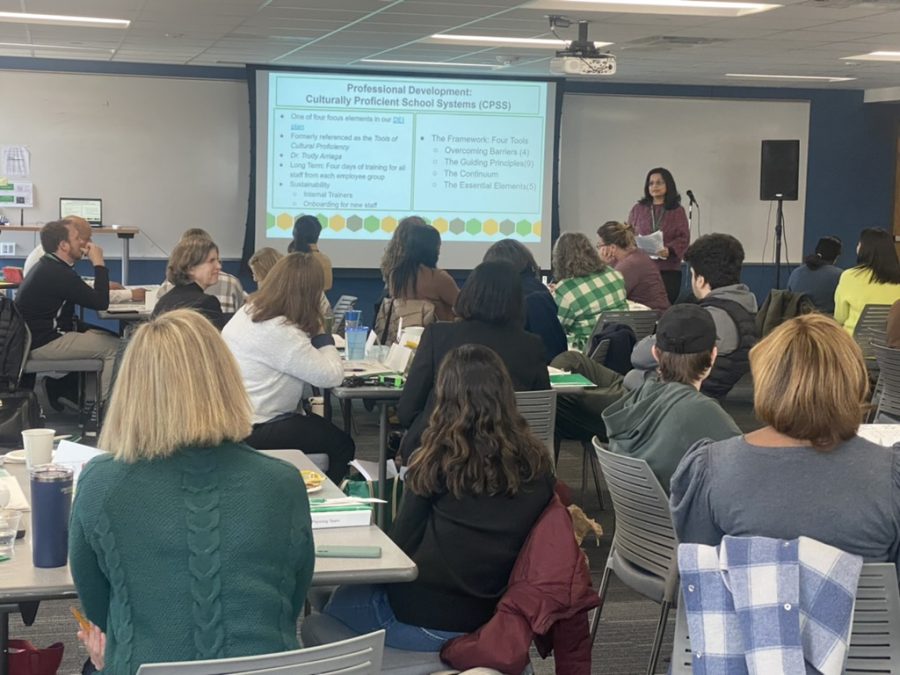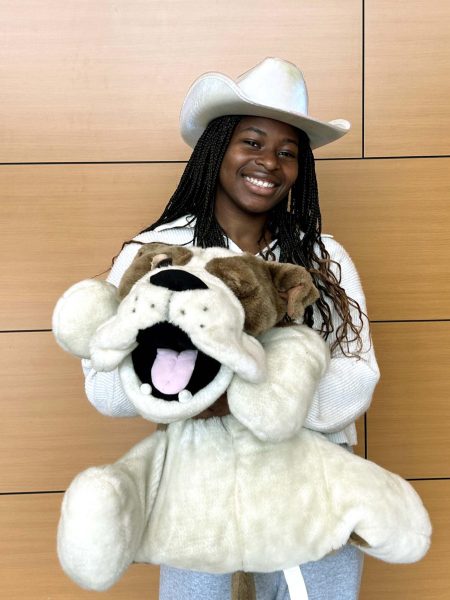Edina’s Core Planning Team extensively reviews Edina Public School’s Strategic Plan
Dr. Sayali Amarapurkar presents on Strategy B: Ensure an Equitable and Inclusive School Culture to the Core Planning Team.
May 1, 2023
On March 30 and 31, the Core Planning Team met at the Edina Community Center for the second time to discuss Edina Public Schools’s Strategic Plan. Team members consisted of parents, administrators, teachers, building staff, and students. The plan, which took 22 months of development and was implemented in 2020, lays out strategies that schools within the district follow to ensure that students reach their full potential in academic and personal success. For 12 hours, the team heard updates from EPS faculty and students about the plan’s effects on stakeholders and provided input on opportunities that could bolster its strategies.
The meeting was organized and facilitated by board members of PartnerEd, a local organization headed by Denise Pontrelli, who helped lead last year’s meeting. Director Paula O’Loughlin and Senior Education Consultant Dr. Teri Staloch directed the meeting, hoping to help lead the group toward EPS’s continued improvement.
“You could just feel how invested people are in wanting [EPS] to be the best place for all students and also really being able to feel the support for Stanley and her team,” O’Loughlin said. “Also, I think most of the adults would agree based on the feedback when we were doing some debriefing and processing, that just the impact of student voice, both on the committee [and] the student voice that was amplified in the presentations, was exceptional.”
Presentations for the plan supplied members with information about each strategy and allowed them to provide suggestions. From Strategy A: Advance Academic Excellence, Growth, and Readiness to Strategy E: Engage Parents, Schools, and Community, the Core Planning Team took notes and discussed within their small groups what they liked, what could be improved, and questions they wished to pose to the whole team and presenters for clarification.
New to the district in 2022, EPS Director of Human Resources Sonya Sailer was excited to hear about the steps outlined in the Strategic Plan. The program Language Essentials for Teachers of Reading and Spelling (LETRS), which trains PreK through 2nd grade teachers to better educate students on phonetics, was popular among many adults on the team, including Sailer.
“When I’m listening to the different presentations across all the different strategies, I’m excited about things that I know will support both employees and students. Ultimately, when you have employees that are engaged and have the opportunity to provide programs like LETRS, I know that that will engage employees and that will absolutely support students in their educational goals,” Sailer said.
Strategy D: Develop Leadership Throughout the District was presented by Edina High School’s Somali Student Association (SSA). Co-led by junior Adna Elmi, she and three other members explained the purpose of the association: creating relationships between parents and the district, providing tutoring services to Somali students, and making clubs and activities more well known, among other undertakings.
Thuy Anh Fox, a mother of two kids at Edina, especially resonated with the mission of SSA. As a child of immigrant parents, Anh Fox commended the efforts SSA members are taking to make sure that their parents were up-to-date and engaged in the school community.
“I just understand so much, how much of a weight those students are carrying, because they know that it’s crucial for the community to succeed together if they get on board with these things. Doing it alone is very isolating. It doesn’t lead to success,” Anh Fox said. “It can be a huge source of conflict intergenerationally between their parents and themselves, so it’s a lot to handle.”
Additionally, Tricia Pettis, the Dean of Students and Instructional Coach at Southview Middle School, resonated with the SSA presentation. Directing the student leadership groups at SVMS, Pettis took value in hearing their perspective on inclusion.
“A student from the SSA said we have to figure out how to fit in and be ourselves. I think that’s just so enlightening for us all and just kind of stops us in our tracks and really think about what does that mean?” Pettis said. “So, when we’re trying to talk about belonging for all, we have to ask, what does that look like? What does that feel like? How can we achieve that?”
The process to review the Strategic Plan also involved discussions about each strategy’s strengths, opportunities, aspirations, and results (SOARs). While all strategies had a relatively equal ratio of SOARs, many members noticed that an opportunity for Strategy C became a significant topic of discussion. Within its description, Strategy C failed to mention the mental and physical well-being of staff in addition to students.
“I also appreciated hearing the critical feedback, as well. Because something like in Strategy C—why isn’t it about [the] mental health of staff and students?” Stanley said, noting that the change will be presented to the School Board for approval. “I’ve learned that there are some places in our system where we are doing an excellent job to really meet the needs of our students, to really help our staff be the best teachers that they can be. And then, I learned we really, really have to dig deeper into staff mental health and wellness and find that balance.”
“The perspective of not only healthy students but healthy staff [resonated with me]. I think that’s really important because without the staff we’re not able to have a successful school system,” freshman George Sill said.
Towards the end of the second day, discussions centered around how to create a balance between student wellness and rigorous coursework. Team members also realized the difficulty for some students to self-select a manageable course load when many students struggle to identify they can be suitable to employers without going to a selective college or university.
In support of preparing students for the workforce, Dr. Stanley described a goal of the district that aims to eventually have Edina students on a pathway that focuses on a particular subject and allows them to earn a microcredential in a STEM field.
“I liked that we had students who had different perspectives about AP tests, and the rigors of school and extracurricular activities, and all of that. But I really did appreciate the conversation about how we’re preparing our students for pathways beyond college to include these work experiences,” Edina mom Stephanie Pierce said. “This concept of being led, leading teams, working with other people who may not look or come from the same area as you, could be relevant regardless of what people do after high school.”
Regarding future awareness, Anh Fox hopes to spread the message to her community about the district’s Strategic Plan and their search for feedback.
“I just truly believe that the more people know, the more people are engaged, and the more they will care about what happens. And, if things are happening that they don’t agree with, then, they’ll feel more comfortable either understanding the decisions or respectfully speaking up about it.”



